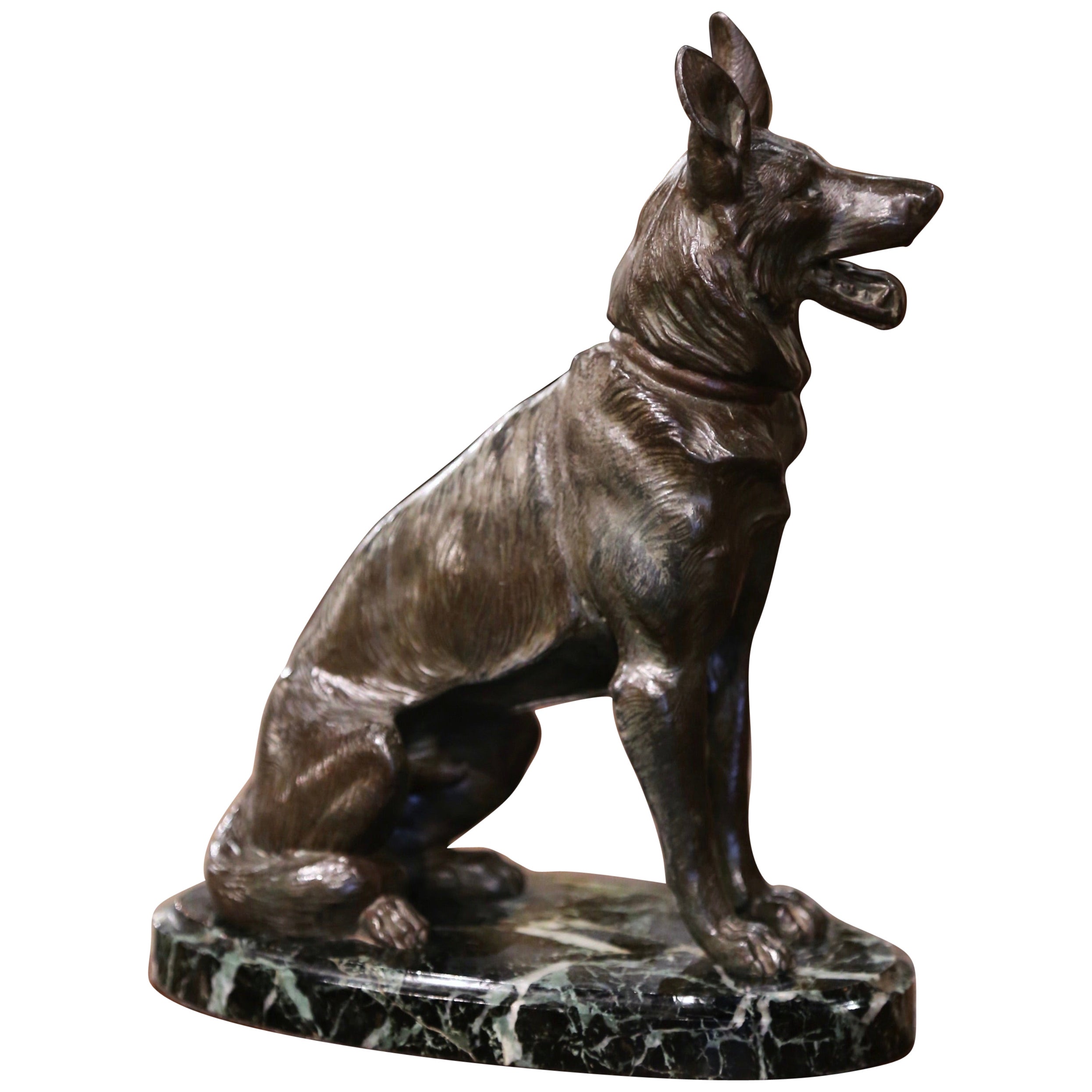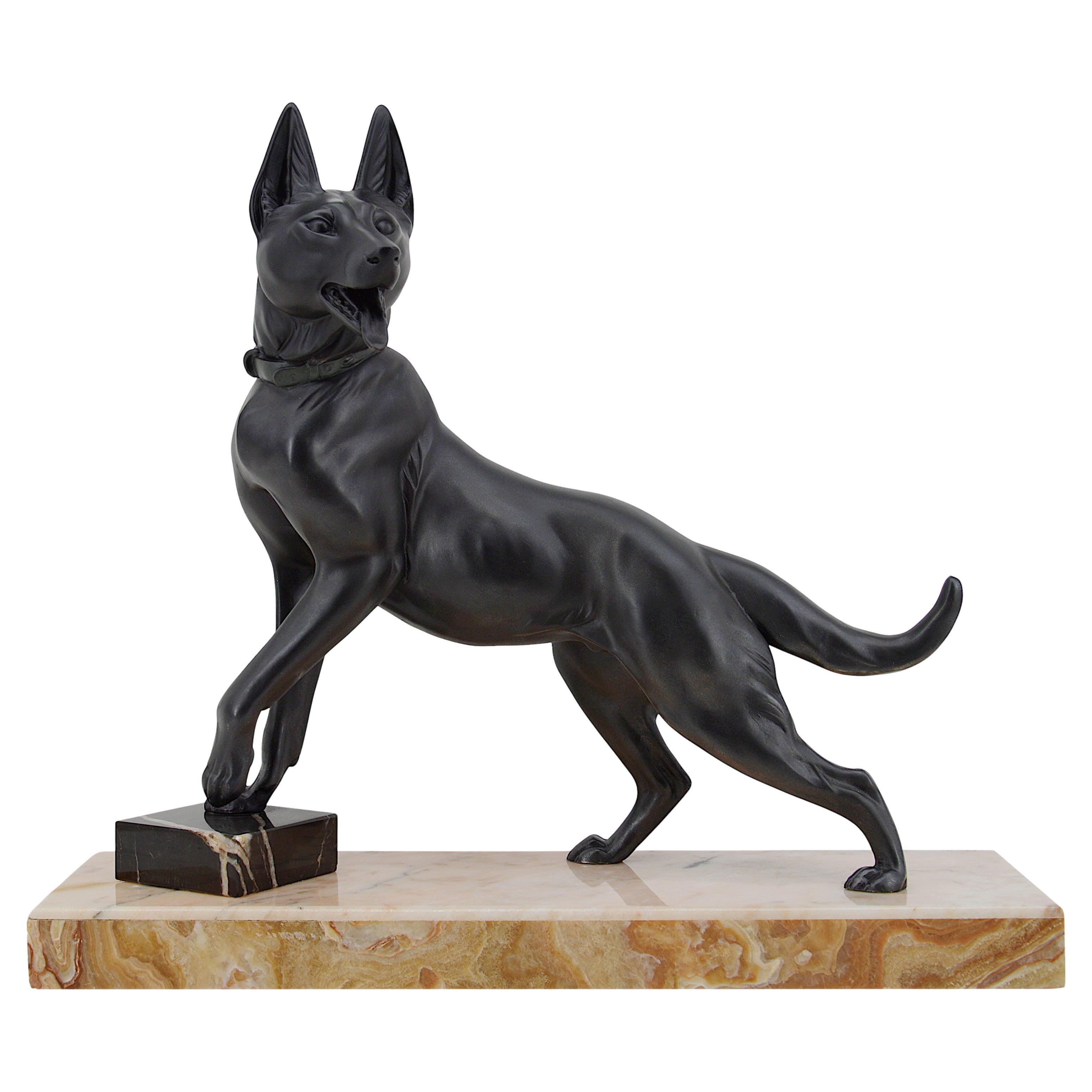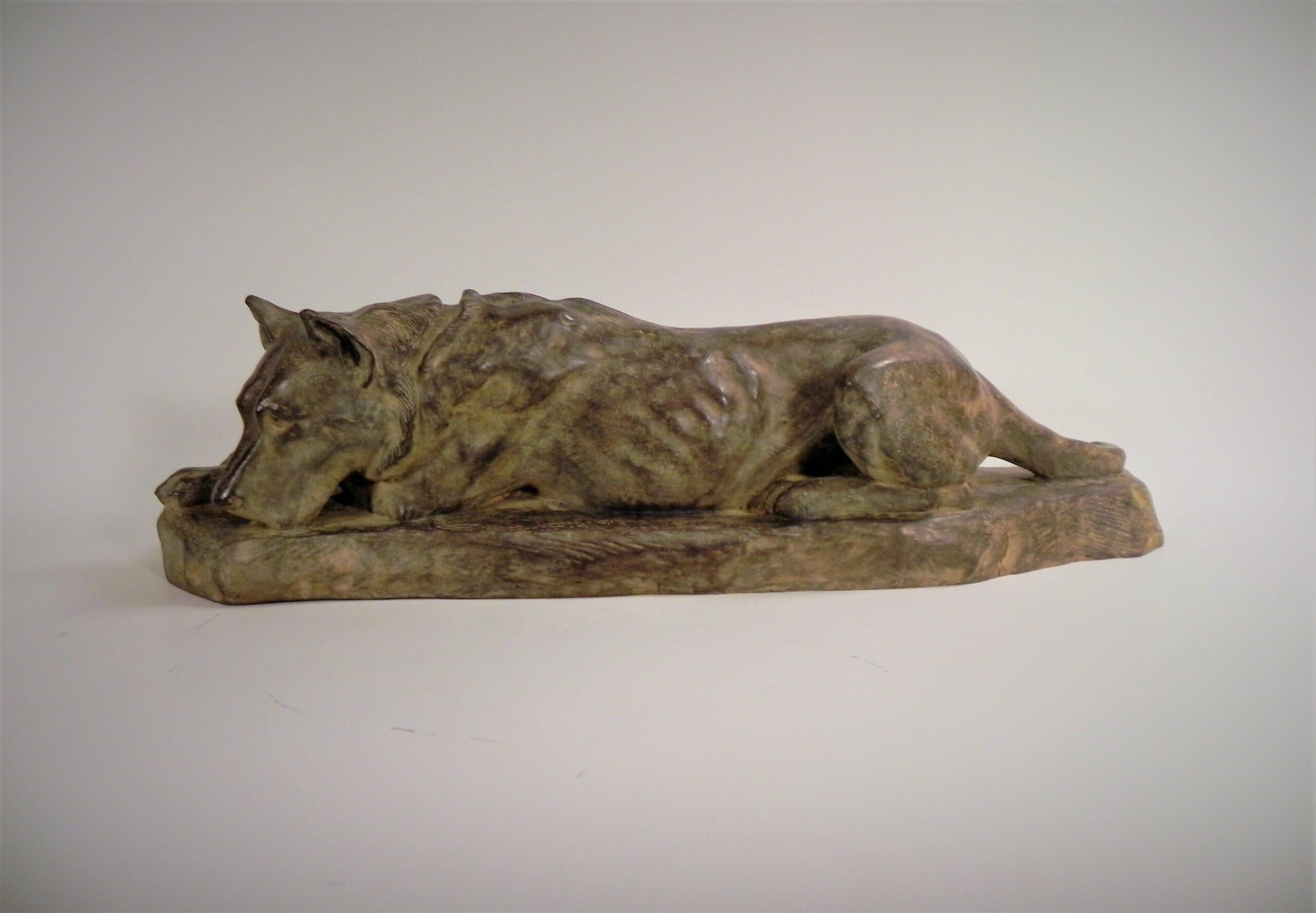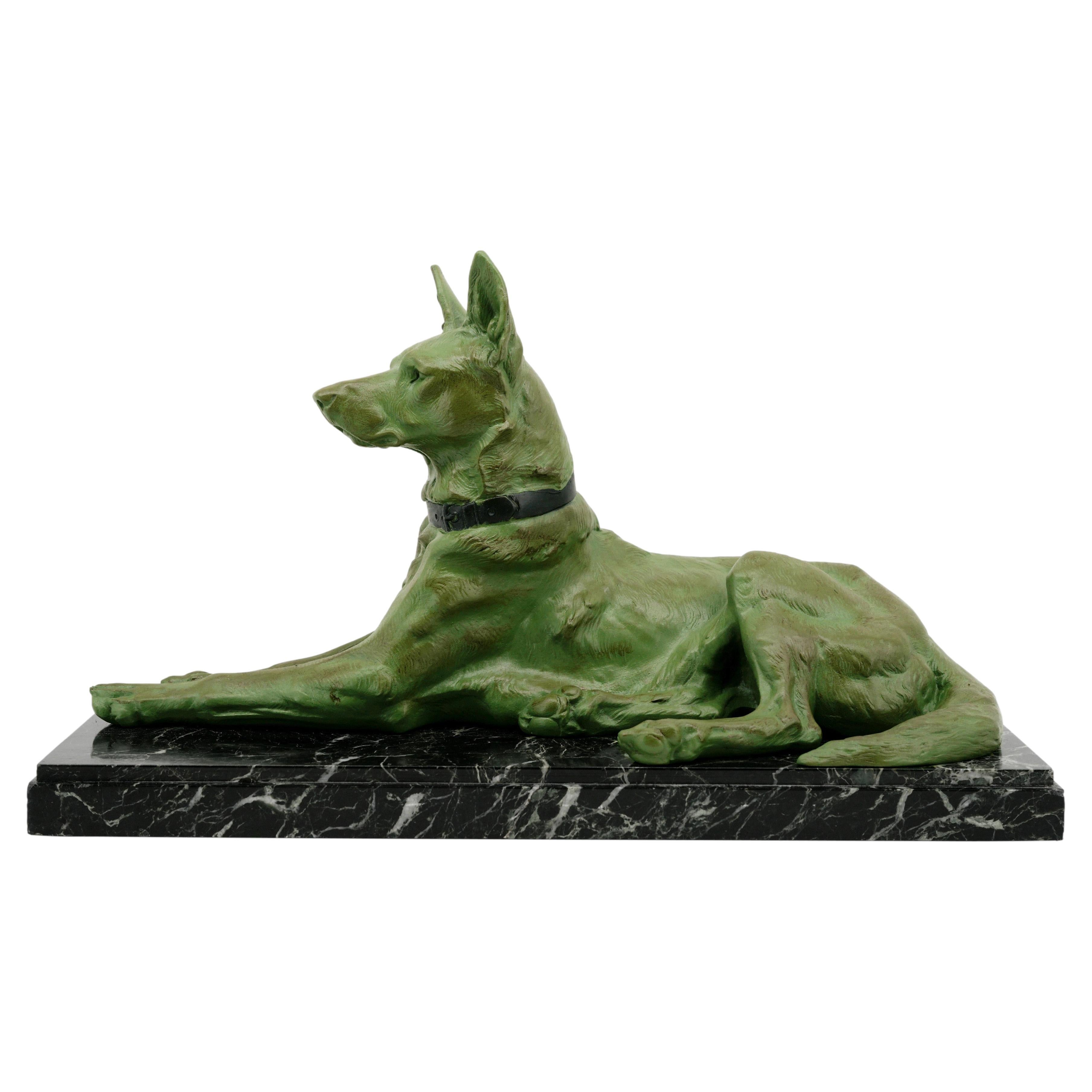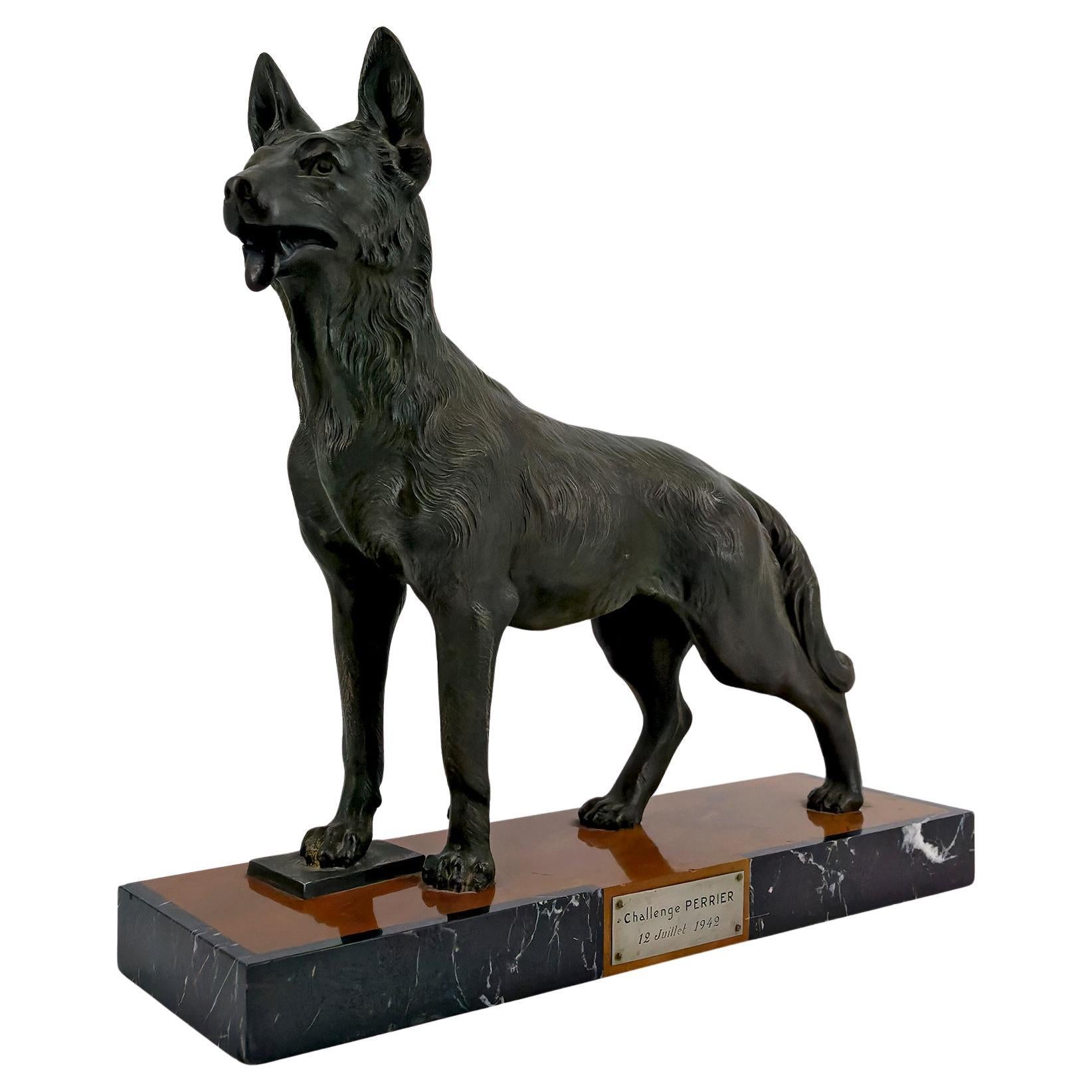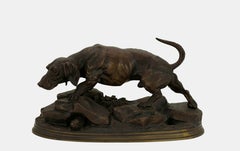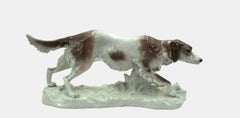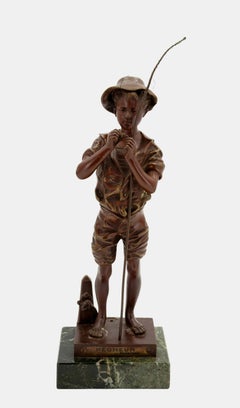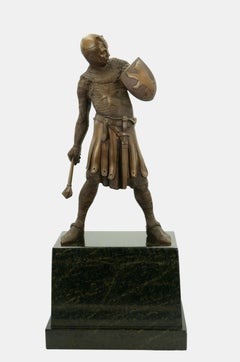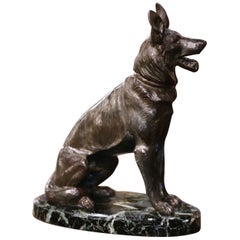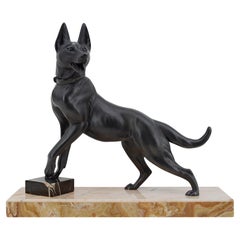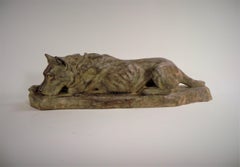Items Similar to Vigilant Sitting German Shepherd / - The Epitome of the German Shepherd -
Want more images or videos?
Request additional images or videos from the seller
1 of 20
Albert Pierre LaPlanche Vigilant Sitting German Shepherd / - The Epitome of the German Shepherd -c. 1915
c. 1915
$3,343.89
$4,179.8720% Off
£2,472.71
£3,090.8820% Off
€2,800
€3,50020% Off
CA$4,593.16
CA$5,741.4520% Off
A$5,107.33
A$6,384.1720% Off
CHF 2,673.78
CHF 3,342.2320% Off
MX$62,387.03
MX$77,983.7920% Off
NOK 33,598.70
NOK 41,998.3720% Off
SEK 31,606.31
SEK 39,507.8820% Off
DKK 21,319.84
DKK 26,649.8020% Off
About the Item
Albert Pierre LaPlanche (1854 Sainte-Menehould - 1935 Chäteau-Thierry), Vigilant sitting shepherd dog, around 1915. Brown patinated bronze on cast terrain plinth. 45 cm (height) x 45 cm (length) x 18 cm (width), weight 13.4 kg. Signed “LAPLANCHE” on the plinth, with the foundry stamp “Syndicates des Bronzes Paris” and the foundry abbreviation “B.D”.
- Two casting-related defects on the back and in the neck area, otherwise in excellent condition for its age
- The Epitome of the German Shepherd -
Unusually large for Albert Pierre LaPlanche's oeuvre, this shepherd dog sits in a figure-eight pose with his ears pricked. He gazes intently at something and, although calmly seated, is ready to spring at the next moment. The well defined muscles of the hunting and guard dog are already tensed. LaPlanche has captured the animal's instinctive alertness, while at the same time its gaze announces its obedience, as if it had sat down on command to remain in that position.
In spite of the detailed representation, the artist does not get lost in the details. He takes the dog's nature as his starting point, which gives the animal an admirable natural liveliness. Although not every hair is individually shaped, it seems as if every hair is recognizable, with the fur on the head, neck, body, and tail each having a different quality. Even the musculature, which is already emphasized underneath the fur, can be felt, which is further enhanced by the glazed patina.
It is precisely because of its naturalistic, lively appearance that LaPlanche's work represents the epitome of the shepherd dog.
About the artist
Pierre Albert LaPlanche was a Paris-based animal sculptor who was highly regarded for his lifelike representations. He exhibited his work in the Paris Salon several times between 1893 and 1922. LaPlanche was a member of the Société des Artistes Français, founded in 1881. Many of his works are in the Musée des Beaux-Arts in Reims.
GERMAN VERSION
Albert Pierre LaPlanche (1854 Sainte-Menehould - 1935 Chäteau-Thierry), Wachsam sitzender Schäferhund, um 1915. Braun patinierte Bronze auf mitgegossener Terrainplinthe. 45 cm (Höhe) x 45 cm (Länge) x 18 cm (Breite), Gewicht 13,4 kg. Auf der Plinthe mit „LAPLANCHE“ signiert, dem Gießereistempel „Syndicates des Bronzes Paris“ und dem Gießerkürzel „B.D“ versehen.
- zwei gussbedingte Fehlstellen am Rücken und im Halsbereich, sonst in einem altersgemäß ausgezeichneten Zustand
- Der Inbegriff des Schäferhundes -
Der für Albert Pierre LaPlanches Oeuvre ungewöhnlich große Schäferhund sitzt mit gespitzten Ohren in Hab-Acht-Stellung. Er nimmt etwas aufmerksam in den Blick und ist – obwohl ruhig dasitzend – bereit, im nächsten Moment aufzuspringen. Die deutlich herausgearbeiteten Muskeln des Jagd- und Wachhundes sind bereits angespannt. Der Schäferhund ist folglich nicht wie ein Mensch porträtiert, vielmehr hat LaPlanche die instinktive Wachsamkeit des Tieres erfasst, wobei der Blick zugleich von der Folgsamkeit kündet, als ob sich das Tier sich auf Kommando so hingesetzt hätte, um in dieser Haltung zu verharren.
Trotz der detailgenauen Darstellung verliert sich der Künstler nicht im Detail. Bei der Formung des Hundes geht er von dessen Naturell aus, was dem Tier eine bewundernswerte natürliche Lebendigkeit verleiht. Obwohl nicht jedes Härchen einzeln ausgeformt ist, meint man doch, jedes Härchen zu gewahren, wobei das Fell am Kopf, im Halsbereich, am Körper und am Schwanz eine je andere Qualität aufweist. Selbst die bereits hervorgehobene unter dem Fell liegende Muskulatur wird erfahrbar, was durch die lasierende Patinierung verstärkt wird.
Gerade aufgrund seiner naturalistisch-lebendigen Erscheinung stellt LaPlanche mit diesem Werk den Inbegriff des Schäferhundes dar.
zum Künstler
Pierre Albert LaPlanche war ein für seine lebensnahen Darstellungen geschätzter, in Paris tätiger Tierbildhauer. Von 1893 bis 1922 präsentierte er seine Werke immer wieder im Pariser Salon. LaPlanche war Mitglied der 1881 gegründeten „Société des Artistes Français“. Eine Vielzahl seiner Werke befinden sich im Musée des Beaux-Arts in Reims.

About the Seller
5.0
Vetted Professional Seller
Every seller passes strict standards for authenticity and reliability
Established in 2014
1stDibs seller since 2023
21 sales on 1stDibs
- ShippingRetrieving quote...Shipping from: Berlin, Germany
- Return Policy
Authenticity Guarantee
In the unlikely event there’s an issue with an item’s authenticity, contact us within 1 year for a full refund. DetailsMoney-Back Guarantee
If your item is not as described, is damaged in transit, or does not arrive, contact us within 7 days for a full refund. Details24-Hour Cancellation
You have a 24-hour grace period in which to reconsider your purchase, with no questions asked.Vetted Professional Sellers
Our world-class sellers must adhere to strict standards for service and quality, maintaining the integrity of our listings.Price-Match Guarantee
If you find that a seller listed the same item for a lower price elsewhere, we’ll match it.Trusted Global Delivery
Our best-in-class carrier network provides specialized shipping options worldwide, including custom delivery.More From This Seller
View AllHunting dog on the prowl / - Following the scent -
By Jules Moigniez
Located in Berlin, DE
Jules Moigniez (1835 Senlis - 1894 St-Martin-du-Tertre), Hunting dog on the prowl, around 1880. Dark patinated bronze with naturalistic terrain plinth, 16 cm (height) x 30 cm (length...
Category
1890s Naturalistic Figurative Sculptures
Materials
Bronze
Pointer / - The elegance of the hunting dog -
Located in Berlin, DE
Anton Büschelberger (1869 Eger - 1934 Dresden), Pointer, around 1930, made by the Karl Ens porcelain manufactory in Volkstedt (Thuringia), model number 2478, 6. Porcelain with underg...
Category
1920s Realist Figurative Sculptures
Materials
Porcelain
Pecheur / - Full of anticipation -
Located in Berlin, DE
Adolphe Jean Lavergne (1863-1928), Pecheur, c. 1900. Brown patinated bronze with rectangular cast plinth on a green marble base (3 cm high), total height with hinge 37 cm, width 9 cm, depth 8 cm, weight 2.9 kg, signed “Lavergne” on the plinth.
- Base with old drilling and a few oxidized areas, patina occasionally rubbed, somewhat stained in the folds.
- Full of anticipation -
This bronze is the larger, highly detailed version of the fisherman that made Parisian artist Adolphe Jean Lavergne famous. In preparation for fishing, the boy prepares his rod before heading out to sea. The attachment of the iron ring and the rope behind him suggest a quay wall and a boat moored there. However, the depiction is entirely focused on the actual action of the young fisherman: With equal skill and concentration, he bends a hook to connect it to the fishing line. The contrast with his casual clothing, the loose-fitting trousers, the open shirt with its "wild" folds, and, last but not least, the sun hat boldly perched on his neck, reinforces the impression of the attentive care with which he goes about his work. His gaze makes him appear absorbed, as if he has forgotten the world around him and yet he is visibly filled with anticipation of fishing.
GERMAN VERSION
Adolphe Jean Lavergne (1863-1928), Pecheur, um 1890. Braun patinierte Bronze mit rechteckiger gegossener Plinthe auf grünem Marmorsockel (3 cm Höhe), Gesamthöhe mit Angel 37 cm, Breite 9 cm, Tiefe 8 cm, Gewicht 2,9 kg, auf der Plinthe mit „Lavergne“ signiert.
- Sockel mit alter Bohrung und wenigen oxidierten Stellen, Patina mitunter berieben, in den Falten vereinzelt etwas fleckig.
- Voller Vorfreude -
Die Bronzefigur ist die größere äußerst detaillierte Ausführung des Fischers, mit dem der Pariser Künstler Adolphe Jean Lavergne bekannt geworden ist. In Vorbereitung auf das Fischen präpariert der Junge die Angel...
Category
1890s Realist Figurative Sculptures
Materials
Bronze
$687 Sale Price
20% Off
Crusader with shield and mace / - Ready to strike -
Located in Berlin, DE
Josef Moest (1873 Cologne - 1914 Rath), Crusader with shield and mace, around 1910. Bronze on a black marble pedestal (19 cm high). 57.5 cm (total height) x 21 cm (width) x 12 cm (de...
Category
1910s Realist Figurative Sculptures
Materials
Bronze
Young Roman / - Youthful Sprezzatura -
Located in Berlin, DE
Fritz Heinemann (1864 Altena - 1932 Berlin), Young Roman, 1892. Brownish patinated bronze on a cast round plinth, mounted on a red marble base (8.5 cm high), total height 36 cm, dime...
Category
1890s Realist Figurative Sculptures
Materials
Bronze
$859 Sale Price
20% Off
The Victorious David / - The melancholy of the radiant hero -
Located in Berlin, DE
Henri Honoré Plé (1853 Paris - 1922 Paris), The Victorious David, around1890. Red-brown and brown patinated bronze with terrain plinth mounted on a round base. 42 cm (total height) x...
Category
1890s Realist Figurative Sculptures
Materials
Bronze
$1,815 Sale Price
20% Off
You May Also Like
Mid-Century French Spelter German Shepherd Sculpture on Marble Base
Located in Dallas, TX
Decorate a man's office or library with this vintage spelter dog sculpture. Created in France circa 1950, and set on a oval green variegated marble bas...
Category
Mid-20th Century French Animal Sculptures
Materials
Marble, Spelter
Louis-Albert Carvin German Shepherd Sculpture, 1920
By Louis-Albert Carvin
Located in Saint-Amans-des-Cots, FR
Amazing huge German Shepherd sculpture by Louis-Albert Carvin, France, ca.1920. Spelter, marble and onyx. Spelter dog. Marble and onyx base. Height: 16.9"(43cm), width: 19.6"(49.8cm)...
Category
Vintage 1920s French Art Deco Animal Sculptures
Materials
Onyx, Marble, Spelter
"Ground Zero" Bronze German Shepherd Dog Searching for Survivors
Located in Brookville, NY
This sculptor is not only an artist, but a vetrinarian. She knows anatomy as well as she knows breeds and behaviors.. This beautiful bronze depicts a German Shepherd Dog searching ...
Category
Early 2000s Realist Figurative Sculptures
Materials
Bronze
Georges-Lucien GUYOT (1885-1973) German Shepherd Dog
Located in Gent, VOV
Lying German Shepard Dog
A bronze cast of a resting German Shepard Dog, by Georges-Lucien Guyot (1885-1973). An early work, and a cast of 1920 with a brown patina with some reddish u...
Category
20th Century Figurative Sculptures
Materials
Bronze
German or Belgian Shepherd Sculpture 1910s
By Louis-Albert Carvin
Located in Saint-Amans-des-Cots, FR
Large German shepherd sculpture by Louis-Albert Carvin, France, 1910s. Spelter dog. Marble base. Height: 11.8"(30cm), Width: 20.5"(52cm), Depth: 8.5"(21.5cm). Stamp "Fabrication fran...
Category
Vintage 1910s French Art Deco Animal Sculptures
Materials
Marble, Spelter
Important sculpture of a German Shepherd, Trophy for the Perrier Challenge, 1942
Located in VÉZELAY, FR
Important sculpture of a German Shepherd, Trophy for the Perrier Challenge, France, 1942.
We are pleased to present an exceptional piece that will appeal to the most discerning coll...
Category
Vintage 1940s French Art Deco Animal Sculptures
Materials
Marble, Metal, Nickel, Spelter
More Ways To Browse
Stamps Germany
Sitting Sculpture
The Shepherd
Sitting Man
German Hunting
Dog Head Sculpture
German Shepherd
German Shepherds
Shepherd Dog
German Shepherd Antique
Bronze Sitting Figure Sculpture
Large Bronze Dog Sculpture
Bronze Shepherd
German Shepherd Bronze
Nayarit Figure
Nic Fiddian Green
Niso Maman
Osman Jackson
